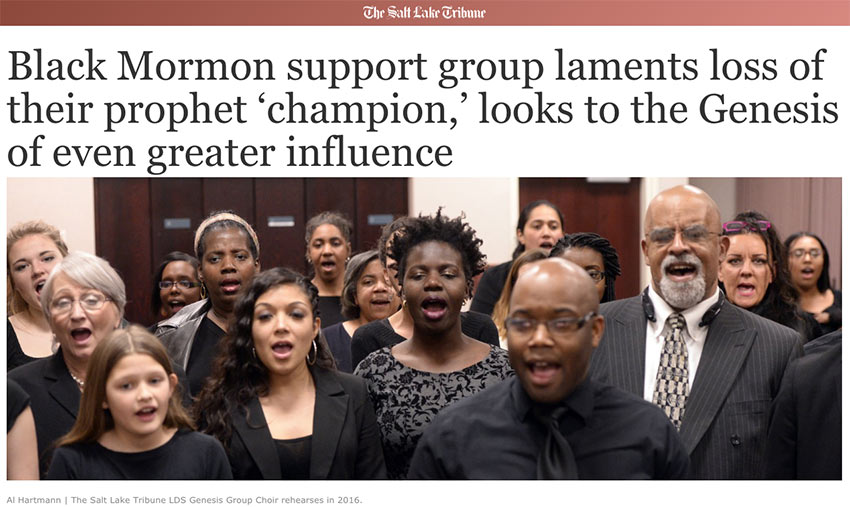Will LGBTQ+ Mormons Ever Find a “Champion” in the LDS President?

By Joel McDonald
The passing of Thomas S. Monson, President of the Church of Jesus Christ of Latter-day Saints, inspired many to share their experiences regarding the late church leader and many articles on his longtime service within the LDS Church. One such article has been on my mind: Black Mormon support group laments loss of their prophet ‘champion,’ looks to the Genesis of even greater influence.
For those who may need a refresher, Genesis was established in 1971 as a way of supporting black men and women who were barred from priesthood service and temple worship. The Salt Lake Tribune describes the organization as, “kind of quasi-branch, or congregation, with a three-man presidency, where black members could meet monthly with others who looked like them, shared their frustrations, their faith and their, well, animated worship style.” Helping to organize Genesis was Thomas S. Monson, who was then serving as an LDS Apostle. Seven years later when the priesthood ban for black members was lifted, Monson was also there.
As a political science student who has studied the civil rights movement, and as a political activist who has worked for pro-equality candidates and policies, I have a deep reverence for the work and sacrifice made by those laboring in the civil rights movement in the 60’s and 70’s. I also know that much of the understanding, language, and strategy used by LGBTQ+ activities was inspired and borrowed from the civil rights movement. In fact, many see the work for LGBTQ+ equality to not be an extension of that movement and not a separate movement altogether.
This view of a continuing movement is not surprising. Consider some of the political goals of the civil rights movement in the 60’s and 70’s were. They sought the right to be able to marry those they loved. They sought access to employment and housing free of discrimination. They sought equal access to public accommodation. This is not an exhaustive list of goals, but they were significant goals of that movement. For LGBTQ+ Americans, these goals are familiar ones. For both African-Americans and LGBTQ+ Americans we have seen significant progress. However, sadly, we still struggle as a society in many of these areas.
Progress in the Mormon Church is not achieved in the same manner as progress in democratic society. While Joseph Smith taught in 1830 that all things in the church be done by common consent, no effectual mechanism for the general church membership to object to a calling or policy change exists. According to the BYU Encyclopedia of Mormonism, “if one or more members find the proposed action objectionable, the dissenting member or members are asked to meet with the presiding officer privately to make known the reason for the question or objection. After considering the objections, presiding officers are free to pursue whatever decision they believe to be right.”
In fact, policy decisions of the LDS Church no longer come before the general body of the church. These decisions are made by church leadership. The only opportunity the general membership of the church has to object to policy decisions is to object when leaders are presented for a sustaining vote of the church. This places members in a difficult position if they have strong objections to policies made by church leaders. Believing that the current church president is a prophet, seer, and revelator is a requirement to be considered worthy to serve in the church and hold a temple recommend. This belief is so foundational that it’s one of the baptismal interview questions according to Preach my Gospel, where it instructions missionaries to ask candidates for baptism, “Do you believe that [current Church President] is a prophet of God?”
But some do object. In recent general conferences, when the first presidency and quorum of the twelve have been presented for a sustaining vote, it is normal for the camera to pan out to show conference attendees silently raising their right hands in a sustaining vote. When the opportunity to oppose is given, the audience isn’t always shown. However, some have taken to vocally opposing, their opposition ringing out through the massive conference center and being heard in the broadcast, as it was in the April 2015 sustaining of church leaders. Even then, those who oppose are referred back to their local leaders to discuss the objection. Nothing practical comes of it, but the opposition has a symbolic impact. This opposition highlights that there are significant issues the church is wrestling with. LGBTQ+ inclusion is one of them.
While there is certainly much that can be done to make local Mormon wards and branches more inclusive for LGBTQ+ members and visitors, the inability of the general membership of the church to impact church leadership means changes in church policy must come from the top. In 1971, Monson along with Gordon B. Hinckley and Boyd K. Packer helped to establish Genesis. We know from various accounts that church leadership wrestled with the priesthood ban for years. From Michael Quinn’s The Mormon Hierarchy: Extensions of Power, we know that in 1969, the first counselor in the first presidency Hugh B. Brown wrote, “I doubt if we can maintain of sustaining ourselves in the position which we seem to have adopted but which has no justification.” He was writing about the denial of priesthood to those of black African ancestry. That year, Brown successfully had the quorum of the twelve adopt a proposal to end the priesthood ban, but Harold B. Lee managed to persuade them to rescind its vote and the ban was reaffirmed. It wasn’t until Spencer W. Kimball became church president that the ban was lifted. Kimball had supported Brown’s proposal to lift the ban in 1969.
Both the opportunity to expand church membership and activity throughout the world and public criticism of the priesthood ban appear to be clear reasons why church leadership wrestled with that needed change. I hope, however, that some must have also felt the policy to be intrinsically wrong. They must have believed that discrimination was spiritually corrosive for the church and damaging to individual church members. I believe these leaders are those most likely to be champions for change.
As Genesis saw Monson as such a champion, is there a church leader we can look to as LGBTQ+ Mormons or as family and friends who want to see the LDS Church be more welcoming and inclusive of LGBTQ+ people? Is there a similar wrestling happening among those in the top leadership of the church regarding LGBTQ+ members as there was for black members of African descent? Was the November 5th policy change of 2015 similar to the reaffirmation of the priesthood ban in 1969? If so, it’s time for our champion to emerge. At least, I hope it is.
Have something you would like to share with Affirmation readers? We welcome commentary and opinion that aligns with Affirmation’s vision and values. Please send submissions to [email protected]. Please note that submissions may be edited prior to publishing.
